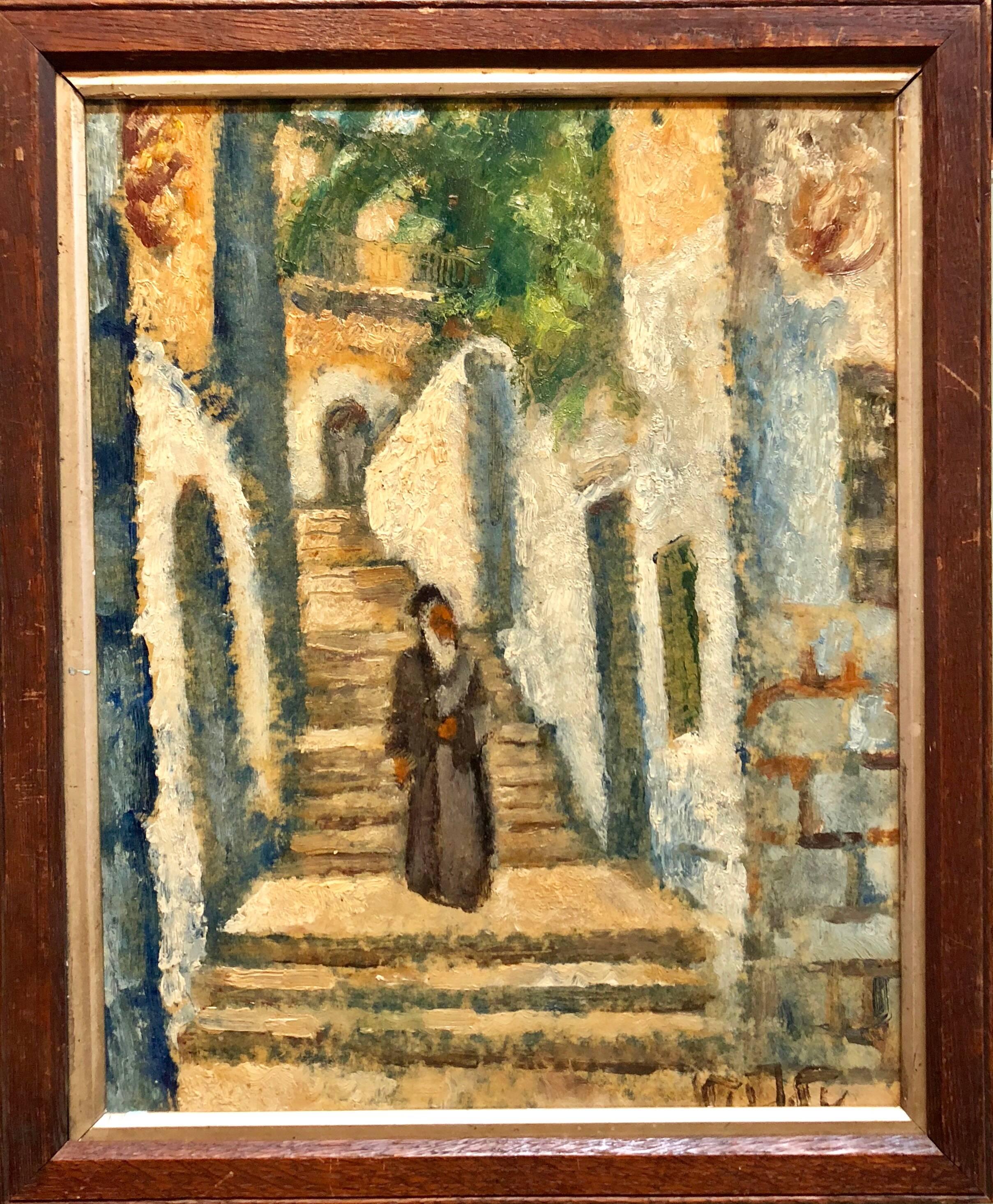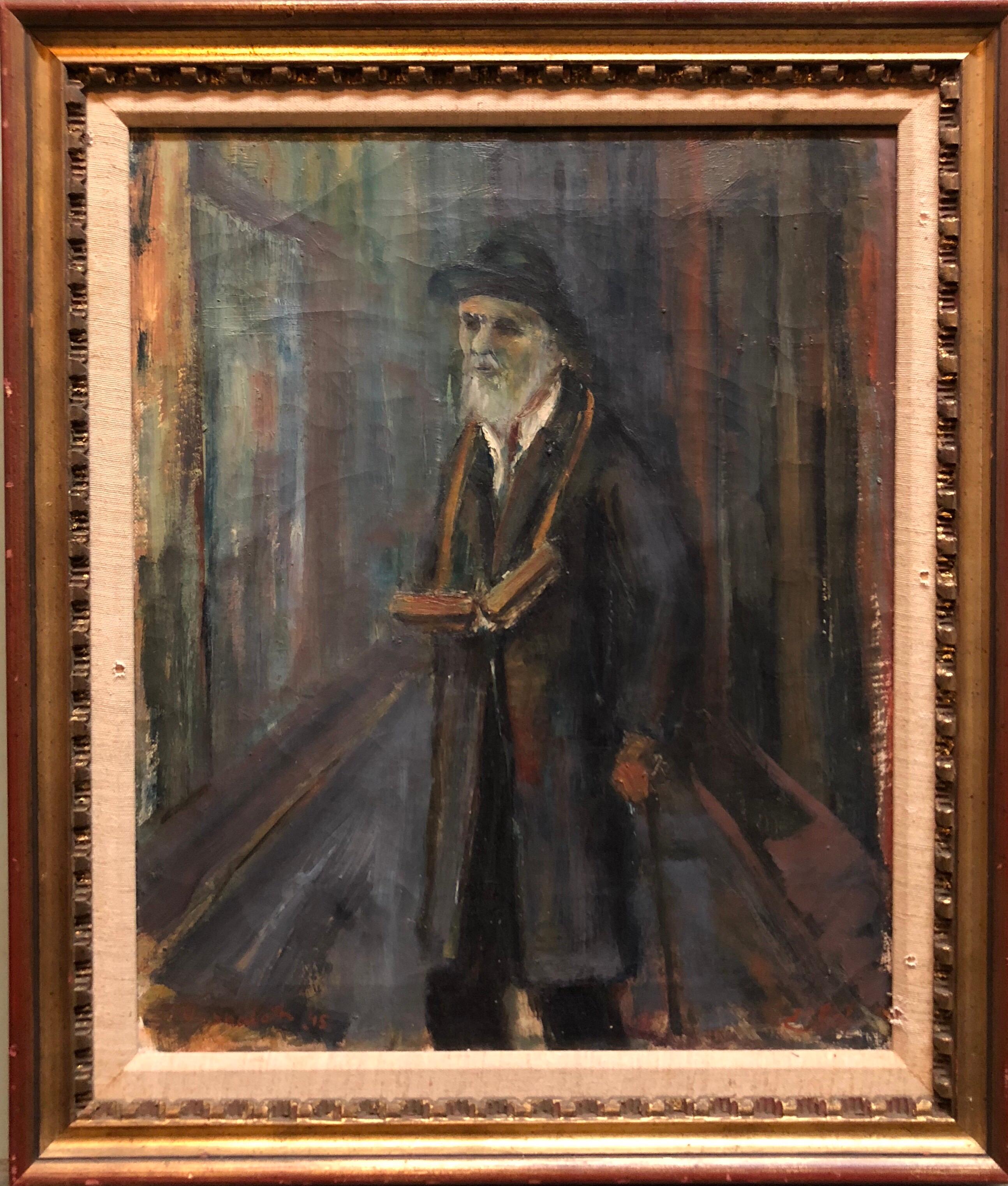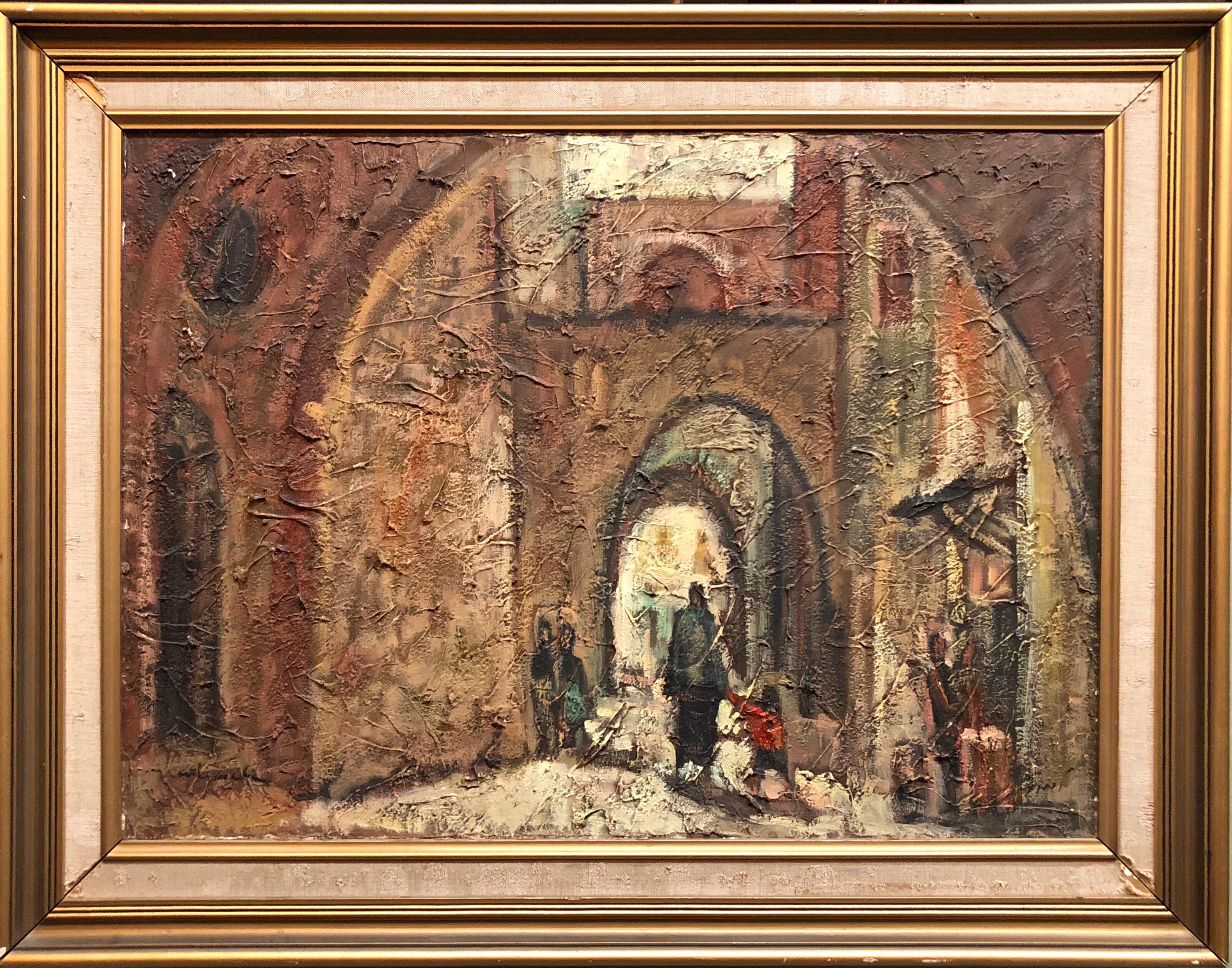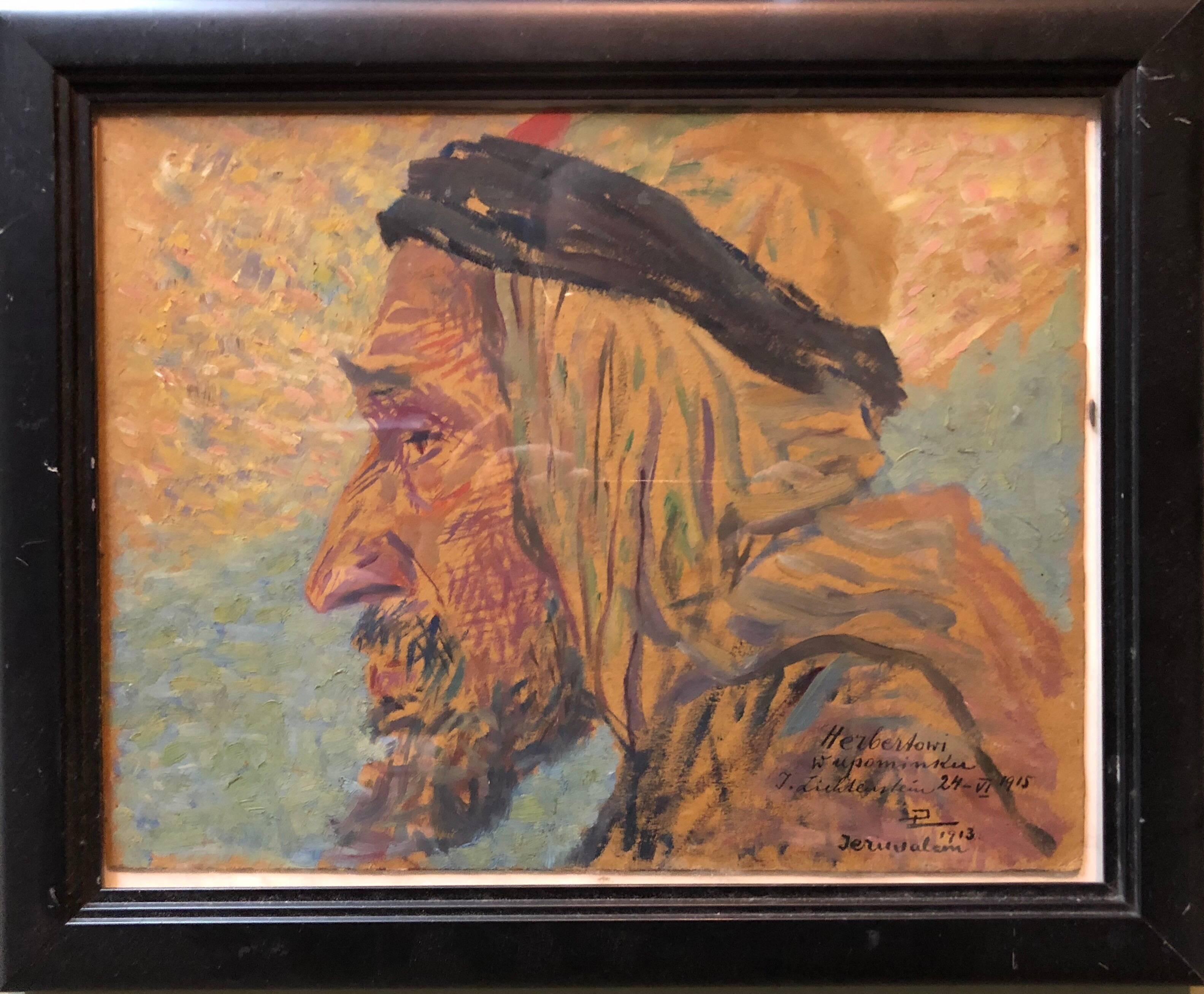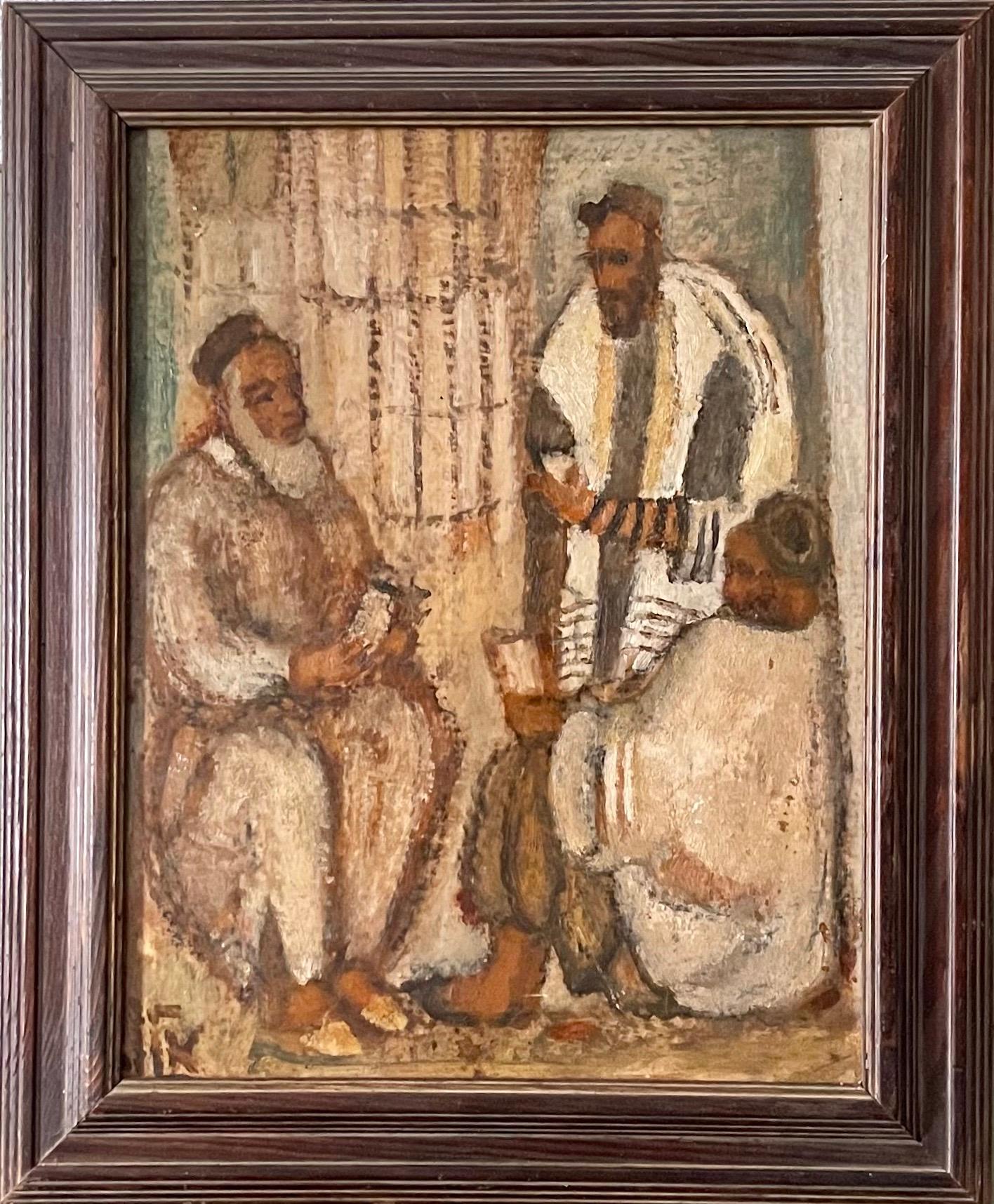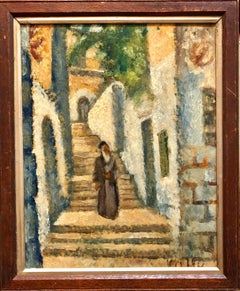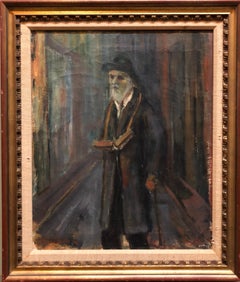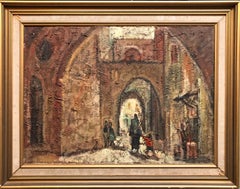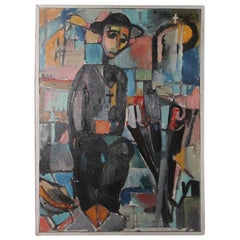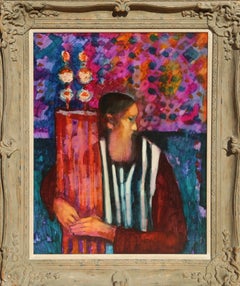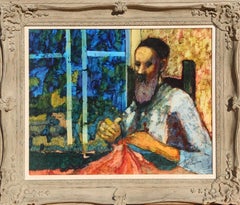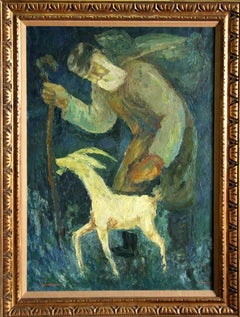Items Similar to Rabbi in Jerusalem, Oil Painting Austrian Israeli Modernist Tel Aviv Museum
Want more images or videos?
Request additional images or videos from the seller
1 of 9
Arieh AllweilRabbi in Jerusalem, Oil Painting Austrian Israeli Modernist Tel Aviv Museum
$3,200
£2,407.07
€2,774.55
CA$4,507.55
A$4,945.86
CHF 2,588.43
MX$60,866.79
NOK 32,610.38
SEK 30,544.48
DKK 20,717.29
About the Item
ARIEH ALLWEIL [ARIE ALWEIL] 1901-1967
Galicia 1901-1967 Safed, Israel (Ukranian/Polish/Israeli)
Arieh Allweil, born 1901, Galicia. Immigrated to Palestine in1920. Studies: 1921-25 Art Academy, Vienna; Dresden Academy. ALlweil brought with him the high values of the Central European avant-garde, which he had absorbed during his years of study in Vienna. He joined the ‘Kunstschau’ group- of artists that had formed around Gustav Klimt and Egon Schiele. He exhibited with them in the 1920’s, and emigrated to Palestine in 1926. He was one of the founders of the Tel Aviv Art Museum and the Midrasha Art Teachers College in Israel. As opposed to other modern Israeli artists in his period, Allweil's woodcuts and illustrations pertained to contemporary events such as the Holocaust and the pioneering spirit before the establishment of the State of Israel. Most notable is this work as well as the first illustrated Passover Haggada for the IDF which he made in 1950 and which was printed for 3 years with his inspirational woodcut illustrations. He published a series of linoleum cuts of Israeli and Biblical subjects and created large scale murals of the Holocaust.
Teaching: In Israel, art. Prizes: Received Dizengoff Prize twice; 1955 Turov Prize for Bible Illustrations. Published series of linoleum cuts of Israeli and Biblical subjects, also illustrated a Passover Haggada and large scale murals of Holocaust. From 1952 until his death lived in Tel Aviv and in Safed in summer. Died 1967, Safed.
Education
1921-25 Art Academy, Vienna, Austria
1921-25 Dresden Academy, Germany
Teaching
Herzliyah Gymnasium High-School, Israel, art.
Tel Aviv High School
Awards And Prizes
1937 Dizengoff Prize for Painting and Sculpture,
Tel Aviv Museum of Art, Municipality of Tel Aviv-Jaffa
1946 Dizengoff Prize
1955 Turov Prize for Bible Illustrations
- Creator:Arieh Allweil (1901 - 1967, Israeli, Ukrainian)
- Dimensions:Height: 24 in (60.96 cm)Width: 20.5 in (52.07 cm)Depth: 2.5 in (6.35 cm)
- Medium:
- Movement & Style:
- Period:
- Condition:Frame has wear.
- Gallery Location:Surfside, FL
- Reference Number:1stDibs: LU38211190812
About the Seller
4.9
Platinum Seller
Premium sellers with a 4.7+ rating and 24-hour response times
Established in 1995
1stDibs seller since 2014
1,803 sales on 1stDibs
Typical response time: <1 hour
- ShippingRetrieving quote...Shipping from: Surfside, FL
- Return Policy
Authenticity Guarantee
In the unlikely event there’s an issue with an item’s authenticity, contact us within 1 year for a full refund. DetailsMoney-Back Guarantee
If your item is not as described, is damaged in transit, or does not arrive, contact us within 7 days for a full refund. Details24-Hour Cancellation
You have a 24-hour grace period in which to reconsider your purchase, with no questions asked.Vetted Professional Sellers
Our world-class sellers must adhere to strict standards for service and quality, maintaining the integrity of our listings.Price-Match Guarantee
If you find that a seller listed the same item for a lower price elsewhere, we’ll match it.Trusted Global Delivery
Our best-in-class carrier network provides specialized shipping options worldwide, including custom delivery.More From This Seller
View AllRabbi in Jerusalem Modernist Israeli Judaica Oil Painting Arie Alweil Viennese
By Arieh Allweil
Located in Surfside, FL
ARIEH ALLWEIL [ARIE ALWEIL] 1901-1967
Galicia 1901-1967 Safed, Israel (Ukranian/Polish/Israeli)
Arieh Allweil, born 1901, Galicia. Immigrated to Palestine in1920. Studies: 1921-25 Art Academy, Vienna; Dresden Academy. ALlweil brought with him the high values of the Central European avant-garde, which he had absorbed during his years of study in Vienna. He joined the ‘Kunstschau’ group- of artists that had formed around Gustav Klimt and Egon Schiele. He exhibited with them in the 1920’s, and emigrated to Palestine in 1926. He was one of the founders of the Tel Aviv Art Museum and the Midrasha Art Teachers College in Israel. As opposed to other modern Israeli artists in his period, Allweil's woodcuts and illustrations pertained to contemporary events such as the Holocaust and the pioneering spirit before the establishment of the State of Israel. Most notable is this work as well as the first illustrated Passover Haggada for the IDF which he made in 1950 and which was printed for 3 years with his inspirational woodcut illustrations. He published a series of linoleum cuts of Israeli and Biblical subjects and created large scale murals of the Holocaust.
Teaching: In Israel, art. Prizes: Received Dizengoff Prize twice; 1955 Turov Prize for Bible Illustrations. Published series of linoleum cuts of Israeli and Biblical subjects, also illustrated a Passover Haggada and large scale murals of Holocaust. From 1952 until his death lived in Tel Aviv and in Safed in summer. Died 1967, Safed.
Education
1921-25 Art Academy, Vienna, Austria
1921-25 Dresden Academy, Germany
Teaching
Herzliyah Gymnasium High-School, Israel, art.
Tel Aviv High School
Awards And Prizes
1937 Dizengoff Prize for Painting and Sculpture,
Tel Aviv Museum of Art, Municipality of Tel Aviv-Jaffa
1946 Dizengoff Prize
1955 Turov Prize for Bible Illustrations
Select Solo Exhibition:
1933 Tel Aviv Museum, Solo Exhibition
1942 Katz Gallery, Tel Aviv
1950 Tel Aviv Museum, Tel Aviv
1956 The Blue Dome, Safed
1968 Memorial Exhibition of the artist Arieh Allweil Yad Labanim Museum, Petach-Tikva
1969 Solo Exhibition The Knesset, Jerusalem
1987 Arieh Allweil: 1901-1967 - ''Return to Betanya Ilit'' Beit Gabriel, Zemah
1994 Arieh Allweil: Prints and Caligraphy The Isaac Kaplan Old Yishuv Court Museum,Jerusalem
2011 Arieh Allweil, Letters, Figures, Landscapes
Mishkan Le'omanut, Museum of Art, Kibbutz Ein Harod
Select Group Exhibitions
1929 Eged - Palestine Painters Group Allenby Street, Tel Aviv
Artists: ChanaOrloff, Abraham Melnikoff, Reuven Rubin, Nachum Gutman, Sionah Tagger, Arieh Allweil, Haim Gliksberg, Yossef Zaritsky, Leon Arie Fein, Pinchas Litvinovsky, Elias Newman.
1932 The Bezalel National Museum, Jerusalem
Artists:
Litvinovsky, Pinchas Gutman, Nachum Allweil, Arieh
Exhibition of Artists: P. Litvinovsky, A. Allweil, N. Gutman
1936 First Exhibition of ''Hever Omanim'' Steimatzky Galleries, Jerusalem
Artists:
Gutman, Nahum Holzman, Shimshon Moshe Mokady, Miron Sima, Jakob Steinhardt, Zeev Ben Zvi, Moshe Ziffer, Allweil, Arieh.
1944 Collective Annual Exhibition by Palestinian Artists
Art Gallery of the ''Habima'' Building, Tel Aviv
Artists:
Hermann Struck, Hermann Moshe Sternschuss, Arie Reznik, Aaron Priver, Itzhak Danziger, Itzhak Zvi Aldouby, Menahem Shemi...
Category
20th Century Modern Figurative Paintings
Materials
Canvas, Oil
Judaica Oil Painting 1945 Palestine Old Jewish Man Polish Israeli Artist
By Ozer Shabat
Located in Surfside, FL
Ozer Shabat 1978-1901
Ozer Shabbat was an Israeli painter, a resident of Haifa. Belonged to the Palestine Expressionist group of the late 1920s and early 1930s.
Shabbat was born in Wolbrom, Poland. At the end of the First World War he went to Holland for agricultural training in the framework of the HeChalutz movement, prior to his immigration to Palestine. In 1920 he immigrated to Eretz Israel and joined the Hulda group. Later he joined the Merhavia group and there he began painting. Because of his desire to study drawing, he left the group and moved to Jerusalem. In 1921, he wrote articles in the newspaper "HaSadeh" on the subject of agriculture and Dutch cheese.
Ozer Shabath won the first prize in a competition for the design of the Dutch Consulate's Garden in Jerusalem, enabling him to travel to Paris in 1923 to study painting. Until 1925 he studied painting at the Grande Chaumiere Academy in Paris. This year he returned to Eretz Israel and settled in Haifa, where he lived until his death.
In 1928 he participated for the first time in an exhibition of Eretz Israel artists at the Tower of David. Since then he has participated in all the general exhibitions of Israeli artists. In 1934, together with painters Menachem Shemi, Avraham Mohar, Zvi Meirovitch and others, he founded the Haifa Artists' Group. In 1935-36 he toured Europe and visited Italy, France and England. During his visit, he maintained contacts with artists from the Jewish school of Paris.
He has exhibited in several solo exhibitions, represented Israel in exhibitions in Europe and participated in international exhibitions in New York, Johannesburg and Zurich. In 1958 he represented Israel in the Venice Biennale. In 1960, Shabat, together with Elchanan Halpern he represented the Israeli Painters Association at the International Congress of Plastic Arts held in Vienna, Austria . In the 40s and 50s he focused on landscape pictures. However, despite the focus on the Israeli landscape, the approach is universal in the framework of the post-Impressionist painting school. In the 1960s, his approach changed and he turned more to abstraction. The abstract direction gradually evolved. The point of departure of the abstract approach is the architectural landscape, but this view loses its real character and becomes only imaginary: the buildings lose their real character and turn into exclusive geometric areas that are usually set against a dark background. Over time, architecture captured the lion's share of his paintings. Cities like Safed, Jaffa and Jerusalem are the subject of many pictures.
He taught painting and art at the schools of the kibbutzim in Ramat Yochanan and Kfar Yehoshua, in high schools in Haifa and in the IDF and Gordon seminars.
His paintings were purchased and are in the permanent collection of the Bezalel National Museum (now the Israel Museum), Haifa Museum of Art, Haifa Maritime Museum, Acre Municipal Museum.
Select Solo exhibitions
1936 - Nadler Gallery, Haifa.
1943 - The Tel Aviv Museum of Art.
1952 - Artists House, Haifa.
1953 - Bezalel House, Jerusalem.
1955 - Gallery in Geneva, Switzerland.
1955 - The Writers' Club, Haifa.
1959 - Artists House, Haifa.
1960 - Museum of Modern Art, Haifa.
1962 - Museum of Modern Art, Haifa.
1963 - Gallery 220, Tel Aviv.
1968 - The Municipal Museum of Beit Emanuel, Ramat Gan.
1979 - Memorial exhibition marking the first anniversary...
Category
1940s Post-Impressionist Figurative Paintings
Materials
Canvas, Oil
Rabbi in Old Jerusalem Painting
By Isaac Frenel
Located in Surfside, FL
Yitzchak Frenel Frenkel, Israeli Master
In 1920, he established the artists' cooperative in Jaffa and an artists' studio in Herzliya. Later that year, he traveled to Paris where he studied at the École des Beaux-Arts and at the Académie de la Grande Chaumière at the studios of the sculptor Antoine Bourdelle and painter Henri Matisse. He was one of the leading Jewish artists of École de Paris. Frenkel returned to Palestine in 1925 and opened the Histadrut Art School in Tel Aviv. His students included Shimshon Holzman...
Category
20th Century Expressionist Figurative Paintings
Materials
Canvas, Oil
Jerusalem Old City Cityscape Israeli Modernist Oil Painting Signed in Hebrew
Located in Surfside, FL
Signed Nathanson. Could be the famous artist Avraham Naton (Natanson) I am not certain. it is a very lovely Modernist Israeli landscape.
Avraham Naton (Natanson), Israeli, born in Bessarabia, 1906-1959. Avraham Naton was born in Rani, Bessarabia to a large secular family. In 1935, after Art studies in Romania, he immigrated to the Land of Israel and settled, first, in Givat Haim and later in Ramat Gan. From the 1940s he worked as an Art teacher in Ramat Gan and Givataim. In 1948 he worked as an illustrator at BaMahane Newspaper. He was one of the Founders of New Horizon Group. Between 1952-1959 he was a member of the Milo Club and served as the club secretary.
Education
1930-33 Art Academy, Bucharest, Romania
Teaching
1940's Ramat Gan and Givataim
Awards And Prizes
Jerusalem Prize for Painting and Sculpture
1942 Dizengoff Prize
1953 Milo Club Prize
New Horizons, The Ofakim Hadashim art movement began with a group of artists who mounted an exhibition in Tel Aviv's Habima national theater in December 1942, under the name "The Group of Eight". The group evolved into a coherent artistic movement only after the founding of the state of Israel in 1948. Members of the school included Arie Aroch, Zvi Meirovitch, Avraham Naton (Natanson), Avigdor Stematsky and Yehezkel Streichman. The work of sculptor Dov Feigin also appeared in the catalog of the 1942 exhibition, though it was not displayed. In February 1947 five of the original members of the group joined Joseph Zaritsky...
Category
1950s Modern Landscape Paintings
Materials
Canvas, Oil
Rare Oil Painting Arab Man Bezalel School Jerusalem 1913, Judaica
By Isaac Lichtenstein 1
Located in Surfside, FL
Extremely rare work of art from the early Bezalel School of Boris Schatz in Ottoman Palestine. it depicts an Orientalist Arab Sheik in traditional Headwear.
YITSKHOK LIKHTENSHTEYN ...
Category
Early 20th Century Post-Impressionist Figurative Paintings
Materials
Paper, Oil Pastel, Oil
Synagogue Interior Jerusalem Modernist Israeli Judaica Oil Painting Rabbi Prayer
By Arieh Allweil
Located in Surfside, FL
ARIEH ALLWEIL (ARIE ALWEIL) 1901-1967
Galicia 1901-1967 Safed, Israel (Ukrainian/Polish/Israeli)
Arieh Allweil, born 1901, Galicia. Immigrated to Palestine in 1920. Studies: 1921-25...
Category
20th Century Modern Figurative Paintings
Materials
Canvas, Oil, Board
You May Also Like
Oil on Canvas 1969 Depicting Jewish Priest with Signature in the Back
Located in Palermo, Sicily
Oil on canvas 1969 depicting Jewish Priest, with signature in the back.
Category
Vintage 1960s Israeli Mid-Century Modern Paintings
Materials
Paint
$2,303 Sale Price
40% Off
Rabbi, 1970s Oil Painting by Donald Roy Purdy
By Donald Roy Purdy
Located in Long Island City, NY
Artist: Donald Roy Purdy, American (1924 - )
Title: Rabbi with Torah
Year: circa 1970
Medium: Oil on Masonite, signed l.r.
Size: 30 x 22.5 in. (76.2 x 57.15 cm)
Frame Size: 38 x 31 i...
Category
1970s Modern Figurative Paintings
Materials
Masonite, Oil
Rabbi 3, 1970s Framed Modern Oil Painting by Donald Roy Purdy
By Donald Roy Purdy
Located in Long Island City, NY
Artist: Donald Roy Purdy, American (1924 - )
Title: Rabbi 3
Year: circa 1970
Medium: Oil on Masonite, signed l.r.
Size: 24 x 30 in. (60.96 x 76.2 cm)
Frame Size: 34 x 39 inches
Category
1970s Modern Figurative Paintings
Materials
Masonite, Oil
Wanderer - Oil Painting by Chaim Goldberg
By Chaïm Goldberg
Located in Long Island City, NY
Artist: Chaim Goldberg, Israeli (1917-2004)
Title: Wanderer
Medium: Oil on Canvas, Signed on Bottom Right and Left
Size: 39 x 28 inches
Frame Size 46 x 34.5 inches
Category
1960s American Impressionist Figurative Paintings
Materials
Oil
Attributed To Benjamin Kopman "The Rabbi"
By Benjamin Kopman
Located in San Francisco, CA
Benjamin Kopman: 1887-1965. Well listed artist born in Russia, but came to U.S. in 1903. He studied at the National Academy of Design in NYC. He has had auction results over $5000 bu...
Category
1960s Expressionist Figurative Paintings
Materials
Oil
Rabbi, Oil Painting by Donald Roy Purdy
By Donald Roy Purdy
Located in Long Island City, NY
Artist: Donald Roy Purdy, American (1924 - )
Title: Rabbi
Year: circa 1960
Medium: Oil on Masonite, signed l.r.
Size: 36 x 24 in. (91.44 x 60.96 cm)
Category
1960s Post-War Figurative Paintings
Materials
Masonite, Oil
More Ways To Browse
German Painting 1920s
Austria Painting
Painting Oil Jerusalem
Oil Paintings Of Jerusalem
Painting Of Rabbi
Jerusalem 1967
Gustav Oil Paintings
Rabbi Painting
Austrian Oil Painting
Oil Painting Of Rabbi
Dior 1967
Tel Aviv Painting
Rabbi Oil
Safed Israel
Impasto Portrait
Old Master Paintings Of Children
Old Master Copies Painting
Dutch Master Paintings 17th Century
